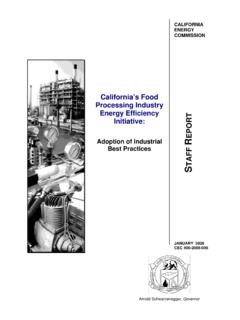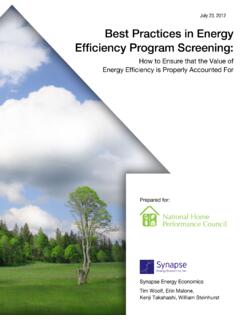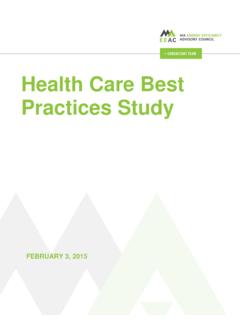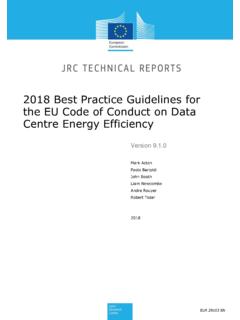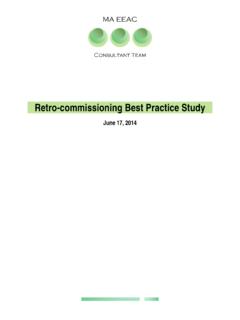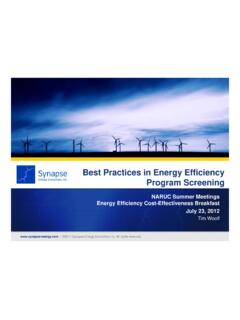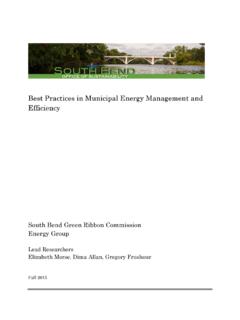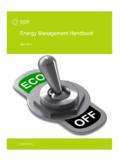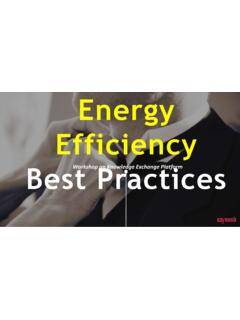Transcription of 6:Energy Efficiency Program Best Practices - US EPA
1 6:Energy Efficiency Program best Practices energy Efficiency programs have been operating successfully in some parts of the country since the late 1980s. From the experience of these successful programs , a number of best practice strategies have evolved for making energy Efficiency a resource, developing a cost-effective portfolio of energy Efficiency pro grams for all customer classes, designing and delivering energy Efficiency programs that optimize budgets, and ensuring that programs deliver results. Overview Cost-effective energy Efficiency programs have been delivered by large and small utilities and third-party pro gram administrators in some parts of the country since the late 1980s. The rationale for utility investment in effi ciency programming is that within certain existing mar kets for energy -efficient products and services, there are barriers that can be overcome to ensure that customers from all sectors of the economy choose more energy -efficient products and Practices .
2 Successful programs have developed strategies to overcome these barriers, in many cases partnering with industry and voluntary national and regional programs so that Efficiency pro gram spending is used not only to acquire demand-side resources, but also to accelerate market-based purchases by consumers. Leadership Group Recommendations Applicable to energy Efficiency Program best Practices Recognize energy Efficiency as a high priority energy resource. Make a strong, long-term commitment to cost-effective energy Efficiency as a resource. Broadly communicate the benefits of, and oppor tunities for, energy Efficiency . Provide sufficient and stable Program funding to deliver energy Efficiency where cost-effective. A list of options for promoting best practice energy Efficiency programs is provided at the end of this chapter. Challenges that limit greater utility investment in energy Efficiency include the following: The majority of utilities recover fixed operating costs and earn profits based on the volume of energy they sell.
3 Strategies for overcoming this throughput disin centive to greater investment in energy Efficiency are discussed in Chapter 2: Utility Ratemaking & Revenue Requirements. Lack of standard approaches on how to quantify and incorporate the benefits of energy Efficiency into resource planning efforts, and institutional barriers at many utilities that stem from the historical business model of acquiring generation assets and building transmission and distribution systems. Strategies for overcoming these challenges are addressed in Chapter 3: Incorporating energy Efficiency in Resource Planning. Rate designs that are counterproductive to energy Efficiency might limit greater Efficiency investment by large customer groups, where many of the most cost-effective opportunities for Efficiency Program ming exist. Strategies for encouraging rate designs that are compatible with energy Efficiency are dis cussed in Chapter 5: Rate Design.
4 Efficiency programs need to address multiple cus tomer needs and stakeholder perspectives while simultaneously addressing multiple system needs, in many cases while competing for internal resources. This chapter focuses on strategies for making energy Efficiency a resource, developing a cost-effective port folio of energy Efficiency programs for all customer classes, designing and delivering Efficiency programs that optimize budgets, and ensuring that those pro grams deliver results are the focus of this chapter. To create a sustainable, aggressive national commitment to energy Efficiency 6-1 programs that have been operating over the past decade, and longer, have a history of proven savings in megawatts (MW), megawatt-hours (MWh), and therms, as well as on customer bills. These programs show that energy Efficiency can compare very favorably to supply-side options. This chapter summarizes key findings from a portfolio level1 review of many of the energy Efficiency programs that have been operating successfully for a number of years.
5 It provides an overview of best Practices in the following areas: Political and human factors that have led to increased reliance on energy Efficiency as a resource. Key considerations used in identifying target measures2 for energy Efficiency programming in the near- and long-term. Program design and delivery strategies that can maxi mize Program impacts and increase cost-effectiveness. The role of monitoring and evaluation in ensuring that Program dollars are optimized and that energy Efficiency investments deliver results. Background best practice strategies for Program planning, design and implementation, and evaluation were derived from a review of energy Efficiency programs at the portfolio level across a range of policy models ( , public benefit charge administration, integrated resource planning). The box on page 6-3 describes the policy models and Table 6-1 provides additional details and examples of programs operating under various policy models.
6 This chapter is not intended as a comprehensive review of the energy Efficiency programs operating around the country, but does highlight key factors that can help improve and accelerate energy Efficiency Program success. Organizations reviewed for this effort have a sustained history of successful energy Efficiency Program imple mentation (See Tables 6-2 and 6-3 for summaries of these programs ) and share the following characteristics: Significant investment in energy Efficiency as a resource within their policy context. Development of cost-effective programs that deliver results. Incorporation of Program design strategies that work to remove near- and long-term market barriers to invest ment in energy Efficiency . Willingness to devote the necessary resources to make programs successful. Most of the organizations reviewed also have conducted full-scale impact evaluations of their portfolio of energy Efficiency investments within the last few years.
7 The best Practices gleaned from a review of these organ izations can assist utilities, their commissions, state energy offices, and other stakeholders in overcoming barriers to significant energy Efficiency programming, and begin tapping into energy Efficiency as a valuable and clean resource to effectively meet future supply needs. 1 For the purpose of this chapter, portfolio refers to the collective set of energy Efficiency programs offered by a utility or third-party energy Efficiency Program administrator. 2 Measures refer to the specific technologies ( , efficient lighting fixture) and Practices ( , duct sealing) that are used to achieve energy savings. 6-2 National Action Plan for energy Efficiency energy Efficiency programs Are Delivered Within Many Policy Models Systems Benefits Charge (SBC) Model In this model, funding for programs comes from an SBC that is either determined by legislation or a regulatory process.
8 The charge is usually a fixed amount per kilowatt-hour (kWh) or million British thermal units (MMBtu) and is set for a number of years. Once funds are collected by the distribution or integrated utility, programs can be administered by the utility, a state agency, or a third party. If the utility implements the programs , it usually receives current cost recovery and a shareholder incentive. Regardless of administrative structure, there is usually an opportunity for stake holder input. This model provides stable Program design. In some cases, funding has become vulnerable to raids by state agencies. In areas aggressively pursuing energy Efficiency as a resource, limits to additional funding have created a ceiling on the resource. While predom inantly used in the electric sector, this model can, and is, being used to fund gas programs .
9 Integrated Resource Plan (IRP) Model In this model, energy Efficiency is part of the utility s IRP. energy Efficiency , along with other demand-side options, is treated on an equivalent basis with supply. Cost recovery can either be in base rates or through a separate charge. The utility might receive a sharehold er incentive, recovery of lost revenue (from reduced sales volume), or both. programs are driven more by the resource need than in the SBC models. This gen erally is an electric-only model. The regional planning model used by the Pacific Northwest is a variation on this model. Request For Proposal (RFP) Model In this case, a utility or an independent system opera tor (ISO) puts out a competitive solicitation RFP to acquire energy Efficiency from a third-party provider to meet demand, particularly in areas where there are transmission and distribution bottlenecks or a gener ation need.
10 Most examples of this model to date have been electric only. The focus of this type of Program is typically on saving peak demand. Portfolio Standard In this model, the Program adminstrator is subject to a portfolio standard expressed in terms of percentage of overall energy or demand. This model can include gas as well as electric, and can be used independent ly or in conjunction with an SBC or IRP requirement. Municipal Utility/Electric Cooperative Model In this model, programs are administered by a munic ipal utility or electric cooperative. If the utility/cooper ative owns or is responsible for generation, the energy Efficiency resource can be part of an IRP. Cost recovery is most likely in base rates. This model can include gas as well as electric. To create a sustainable, aggressive national commitment to energy Efficiency 6-3 Table 6-1. Overview of energy Efficiency programs Policy Model/ Examples Funding Type Shareholder Incentive1 Lead Administrator Role in Resource Acquisition Scope of programs Political Context SBC with utility implementation: California Rhode Island Connecticut Massachusetts Separate charge Usually Utility Depends on whether utility owns generation programs for all customer classes Most programs of this type came out of a restructuring settlement in states where there was an existing infrastruc ture at the utilities SBC with state or third-party implementation: New York Vermont Wisconsin Separate charge No State agency Third party None or limited programs for all customer classes Most programs of this type came out of a restructuring settlement IRP or gas planning model.










